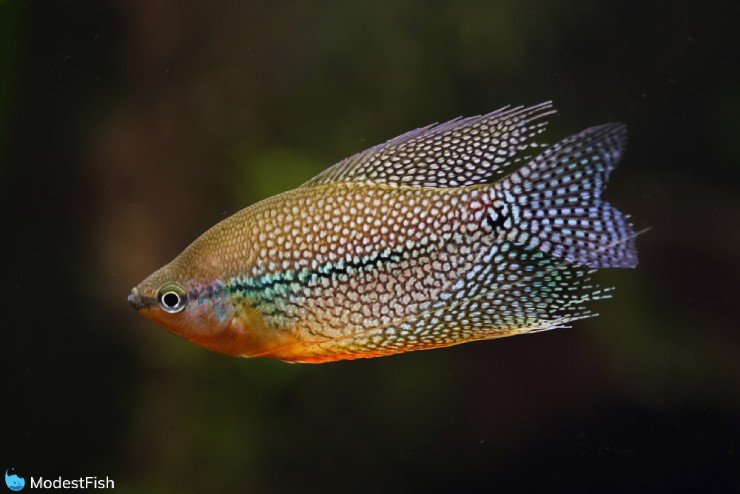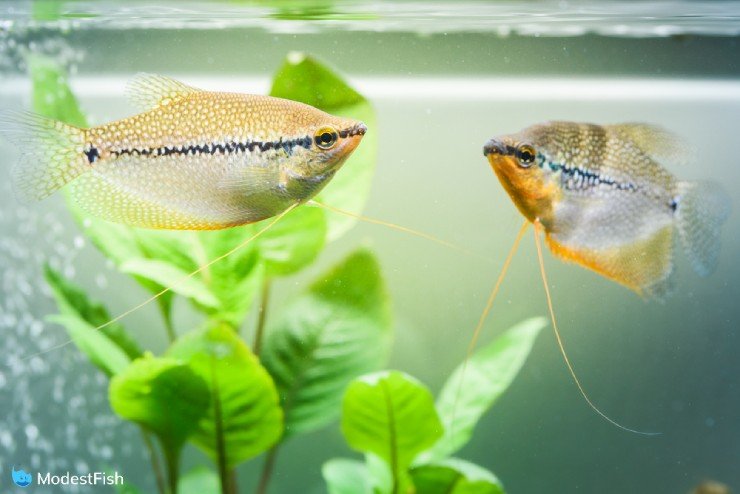The Pearl Gourami is a stunning exotic fish found in freshwater. Part of the Gourami family, it’s known for its beautiful appearance and peaceful temperament. It’s also a popular aquarium choice due to the variety it adds to fish tanks.
To keep the Pearl Gourami healthy, a few things are needed to take care of. Following the pointers given below will give you insight on what to keep in mind.
Overview & Appearance Of Pearl Gourami
The Pearl Gourami (Trichopodus leerii) is a fish characterized by its striking mosaic and mother of pearl-like sheen. It has a unique black line that runs across its head to its tail, ending in a dot. Its ventral elegant angelic fins spray out feelers, and the fish carries a brilliant orange hue that begins at the head and dissipates into a brilliant lucency.

It’s a labyrinth fish, meaning it can breathe by taking in air at the top of the fish tank. In a community aquarium, the Pearl Gourami really stands out with its patterned mosaic sheen and the glowy breast.
It originates in East Asia, specifically Thailand, Malaysia (Borneo), and Indonesia (Sumatra). It occurs in slow-moving freshwater. Thus, you’d find it in lowland swaps by the sea in acidic water.
It can also be found in Singapore and Colombia, where it’s been first introduced. Pearl Gourami is listed as near threatened by the IUCN’s Red List of Threatened Species. Due to extensive water projects and ecosystem changes, its natural habitat has been disrupted.
Care Overview
Pearl Gourami requires some key things for them to thrive. Below are the factors you need to be mindful of to ensure your fish stays healthy.
- Tank Size: A 30-gallon planted community tank with plenty of decorations
- Temperature: 77°F- 82°F (25°C -28°C)
- pH: 6-8.
- kH: 5-25 DH.
- Living Zone: Top-mid dwelling
- Temperament: Peaceful (aggression during breeding periods)
- Diet: Omnivore
Scientific Classification
It’s interesting to know the biology of this fish. Being exotic, it has some interesting scientific facts that make them unique.
- Common Names: Pearl Gourami, Mosaic Gourami, Lace Gourami, Diamond Gourami
- Origin: East Asia, Thailand, Malaysia (Borneo), Indonesia (Sumatra)
- Kingdom: Animalia
- Phylum: Chordata
- Class: Actinopterygii
- Order: Anabantiformes
- Family: Osphronemidae
- Genus: Trichopodus
- Species: T. leerii
- Binomial Name: Trichopodus leerii
Life Span Of Pearl Gourami
Pearl Gourami can live up to about 4-5 years. It is essential that you follow the caring guidelines to maximize its lifespan to its upper limit. Providing good nutrition and living conditions can ensure that this happens.
Males vs. Females: Size & Color Differences
Both sexes have characteristics quite easily noticeable. Males tend to be more thin and angular, whilst females tend to have rounder, heavy-set bodies. Males sport red breasts and are generally more colorful than females, who tend to stay plain colored. You can easily spot the male just by looking out for the orange-red tone they carry around their throats.
The color, of course, gets brighter during mating and is needed to woo the females. Males also have long and pointed dorsal fins, whilst females have shorter and smaller fins.
Care & Tank Set Up For Pearl Gourami
Follow these essential steps to get your tank in perfect conditions to help your Gourami feel right at home.

Tank Size
A 30-gallon tank that is roughly 23 liters would be needed for a pearl Gourami. If you choose to have a few of them, keep in mind that 6 gallons of water are required for one Gourami. So if you want to have just Pearl Gouramis in your tank, 4 to 5 would be enough for a 30-gallon tank.
Also, check that there’s enough space between the surface of the water and the tank’s lid so that they have access to some air.
The Nitrogen Cycle
The Nitrogen Cycle is a biogeochemical system by which nitrogen is converted into various forms. It simultaneously passes from the atmosphere into the soil, then to the organisms, and finally makes its way back into the atmosphere.
For the aquarium, the nitrogen cycle ensures its ecosystem is safe for fish to live. It’s common for beginners to miss this (known as new tank syndrome) and often end in a disaster if skipped.
The Nitrogen cycle plays a part in causing good bacteria to convert toxic nitrite waste, such as ammonia, to nontoxic nitrates. These good bacteria occur in the tank’s filter, helping to neutralize the fish waste. However, too much nitrate can also be harmful as a loss of appetite and algae growth can result.
One of the main ways to keep things in check is keeping the tank clean, i.e., changing the water every week and wiping down excess algae. It will decrease the chances of your fish contracting diseases through the water.
The best way to keep on top of nitrogen levels is by purchasing an aquarium test kit and following further guidelines.
Water Parameters
Whenever discussing water parameters, the key is to maintain stable conditions and not necessarily hit a perfect number. The below are the necessary variables to consider regarding the water in your tank.
- Temperature: Since Pearl Gouramis are tropical fish, they are better matched to warmer water. Aim for about 25°C to 28°C. You can use a tank water heater to set this.
- pH: The excellent thing about Pearl Gouramis is that they are tough and adaptable to handle less acidic pH’s. Although they naturally like acidic water, it’s most likely that your pearl gourami is bred in captivity and therefore can tolerate a more comprehensive pH of 6-8, which is pleasant and neutral.
- kH: For the water hardness, aim to have it at around 5-25 DH. You can adjust the water by adding calcium carbonate (Baking Soda) to increase hardness or using a showerhead filter or electronic water softeners if your water is too hard.
Lighting
Use subdued lighting and dark substrate through leafy greens. This would imitate the swamp-like conditions they originate from.
For this, I would recommend you check out LED aquarium lighting. With so many customizable options, you’ll be able to recreate natural conditions for your Gourami tank.
Plants, Substrate & Decorations
Designing the tank to feel like home for the Pearl Gourami would be the easiest way to make them happy.
In their natural habitat, they would be accustomed to fern and greens. So try to fill your tank with live aquarium plants and make sure they’re alive so that they can be nibbled while also helping to keep the tank clean. Any live ferns and water weeds would be fine as well.
A great addition would be rocks, as their natural habitats are full of them, and lastly, all this should rest on a sandy surface, so make sure to add sand or soft gravel at the bottom.
Diet & Feeding
You have a lot of flexibility when choosing fish food for Pearl Gouramis. They’d be OK to munch on some greens – easy ones could be cooked peas, spinach, and lettuce. It’d be good to mix it up with something more protein-rich to ensure they get whole nourishment.
Some protein-rich foods could be glass/blood worms or even the live or frozen foods available at the pet store.
Sometimes it can be tempting to overfeed your new fish, but be wary of this with the Pearl Gouramis because they will continue to munch on anything you put into the tank. Try to stick to 2-3 times a day.
Initially, it would be a good idea to observe the feeding times. If you notice they keep missing the food, decrease the amount you are giving. This is connected to the Nitrogen Cycle, explained earlier on, as uneaten food becomes organic waste that’ll reduce your water quality and increase toxic nitrites.
Pearl Gourami Temperament & In-Tank Behaviour
Pearl Gouramis are easy-going and peaceful, making them pleasant to pair with fellow critters. However, their male counterparts can be more touchy or aggressive during breeding periods, so if you decide to have more than one Gourami, it’s better to keep one male with several females. This goes for most species!
Tank Mates

Pearl Gouramis make lovely additions to an aquarium, and even having one can liven up a tank with colors and patterns.
The key is to remember not to cram too many males of the same Gourami species. Other small schooling fish can happily live alongside Pearl Gouramis as long as they are not known to be aggressive.
Gouramis tend to prefer being grouped with fish rather than being alone. Some good choices of compatible tank mates may be:
- Pearl danios (Peaceful temperament and small)
- Neon & Small Tetras (Peaceful temperament and small)
- Catfish like Corydoras (Bottom swimmer)
- Loaches like Kuhli (Bottom swimmer)
- Dwarf Gouramis (Peaceful temperament)
- Bristlenose Pleco (Relaxed temperament and bottom swimmer)
- Guppies (Peaceful temperament and small)
Incompatible tank mates would be those that are large, even if they’re peaceful. If they’re larger than a Pearl Gourami, it can cause them to shy away and hide. This may cause them to not come up for air, as they may feel unsafe, resulting in stress.
Always check if the fish you are choosing has an overactive temperament, as these should not be paired with the Pearl Gourami either.
An example would be Tiger Barbs that have a tendency to be fin-nippers. Pearl Gouramis’ fins are very delicate. They can be prone to fin-rot and bacterial infection in their fins, particularly if they get nipped.
Breeding
Feeding the pair something nutritious, such as live worms, before breeding is a good idea. Create a good atmosphere by ensuring you have long floaty plants, a raised temperature of about 27°C or 80°F, and reduce the water content in the tank so that the new fry can easily access air.
The male will come up to the surface to form a bubble nest near the floating plants, and the spawning of eggs will be under that. Once the nest is completed, he will display it to the female, and the two will approach it and be seen bonding with their feelers.
Eggs that the female produces during spawning float upwards towards the nest. These can be up to 300 eggs! Once the eggs have been laid, it’s safer to remove the female, as the male can become aggressive.
The eggs should hatch within a day or two, and it is also essential to keep other fish away, so they don’t end up eating the eggs or new fry and disrupting the process.
Expect baby fish swimming around within four days. After which, the male should be removed to avoid him mistaking the fry for food. Feed the fry with flaky foods, and change the water every 2-3 days to sustain the new fry’s growth and health.
Will You Pick The Pearl Gourami For Your Tank?
There are a few essential pointers to keep in mind when looking after the Pearl Gourami, the main ones being your tank size, temperature, pH, fish food, and general water parameters. It is also vital that general aquarium hygiene is always maintained. Keeping a clean tank will prevent bacterial infections and keep all your fish healthy.
Happy fish are healthy fish, and you can ensure your fish are delighted by jazzing up your tank, adding in greens and colored plants, helping them feel at home and comfortable.
You don’t have to be a fish expert to have a Pearl Gourami; just following basic know-how can help you enjoy having one of these swimming around in your tank.
